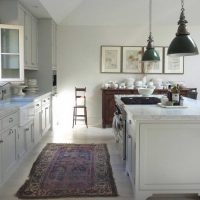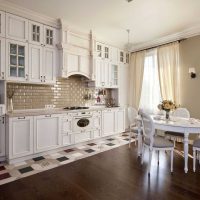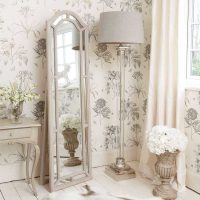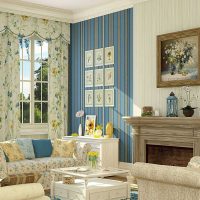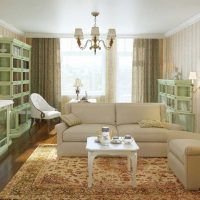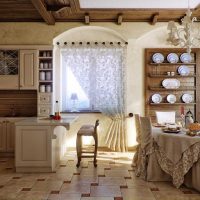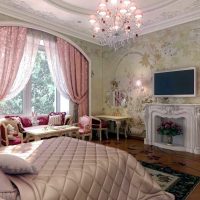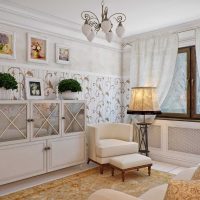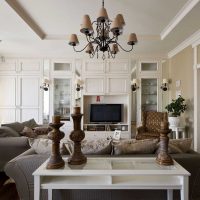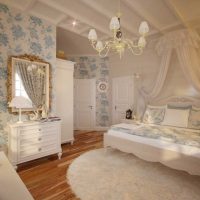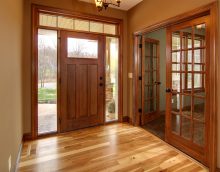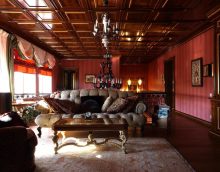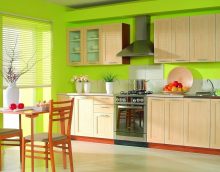Provence style in the interior of a city apartment
In design practice, one of the most revered styles remains provence in the interior. It is one of the most natural and comfortable, as it was formed at the junction of ethno, retro and country. This is a symbiosis of rustic ease and French chic. The stylistics of the European hinterland are preferred by accomplished personalities nostalgic for rural childhood, as well as creative dreamy natures.

Provence style interior

Provence Interior Design Idea

Provence style room design
Content
History and style
The word "province" comes from the name Provence - a region in the south of France with endless lavender fields off the Mediterranean coast. This style is classified as a kind of country (in the free translation “rustic”), but it differs from its analogues by a special French charm.
Initially, the Provence style was established in the interior of provincial houses, where there is enough free space for a large family. Designers adapted it to urban conditions. The special romantic spirit of the outback is easy to recreate in the kitchen and bathroom, living room and bedroom of any city apartment, as in the photo.
Attention: One of the advantages of independent work on creating your own design in the Provence style is a small budget. It will be needed to cover the costs of partial repairs and some reorganization of the space of the rooms.
The legacy part of the old furniture is easily restored and attached to the interior. You will have to find wooden chairs and tables with chiseled legs, as well as lamps and furniture with openwork forging, which creates the illusion of weightlessness.

Provence style in the interior of a modern apartment

Beautiful apartment design in provence style
But the provincial style is recognizable not only for carved furniture and handmade items. It is also an abundance of daylight, a special palette and many colors - from textile patterns to dry compositions of lavender or wildflowers and garden flowers in porcelain pots.
Typical of the Provencal style in the interior is the absence of sharp contrasts and unnatural shades. This is a nice looking palette that repeats the color of the southern regions of France. The shades of wood and fireclay clay, sea water and a cloudless sky complement the natural tones of whitewashed walls, tiled roofs and masonry exterior walls.
In archaic Provence, even bright color accents in textiles and accessories repeat natural colors:
-
crimson sky during sunset;
-
lavender plantations;
-
summer wildflowers;
-
olive groves;
-
shades of wood and fireclay clay;
-
vineyards with bulk berries;
-
ripe fruits from the garden near the village house.
In preference, embroidery and handmade knitted things that are made by yourself or bought at flea markets. By the way, they are very popular in France, where hand-made things and things “with history” are valued. This is a wide canvas for the edge of sheets made on linen, knitted sirloin tablecloths and embroidered sofa pillows with ruffles.
Looking through the design of modern apartments with Provencal stylization, it seems that this is a “female” style, which is suitable only for a bedroom or a nursery.But this is not so, in such an environment many generations of the French are growing up, who have carried a love for the special chic of Provence. It is remembered by many guests of the country - with the smell of lavender and orange groves, with the taste of goat cheese and tart spices.

Provence style interior

Provence Interior Design Idea

Provence style room design
The difference between Provence and country style
Once a characteristic way of life was formed in the outback of Europe under the influence of the townspeople. Runaway wealthy French and Flemings hid from the rebels in remote places with amazing nature and a measured way of life.
They quickly got used to it - sowing fields and raising livestock, cultivating lavender and spicy spices, making wineries and building cheese factories. So wealthy bourgeoisie began to develop the village business. They did not return to Paris and other cities, gradually becoming the indigenous people of Provence with a high level of culture. That is why this is not a rustic style in its purest form, but a noticeably ennobled decor, with a touch of grace and aristocracy.
This is so close to modern townspeople seeking to change the noisy bustle of the gray “stone jungle” for a measured life in unity with nature. Cottages and country houses designed in the design of Provence fit perfectly into the picturesque Russian landscape.

Provence style in the interior of a modern apartment

Beautiful apartment design in provence style
The style is considered akin to other types of country - a typical design of provincial buildings in different parts of the world:
-
exotic "bungalow";
-
American ranch;
-
Russian tower;
-
Ukrainian "huts";
-
Swiss mountain chalet.
These are buildings made from environmentally friendly materials that fit well into the picturesque landscape. But in Provence they are arranged more elegantly, with taste, with the inherent craving for France in aesthetics and elegant chic. The only thing that gives out the “rural” origin of the Provence style is its interior with a lot of animalistic plots and “chintz” colors (small floral ornament).
The decoration of a city apartment in imitation of the traditions of the French provincial largely preserves the characteristic cladding. But time and modern technology are making adjustments. Therefore, in the interior design in the Provence style, you can see many examples with wallpaper on the walls instead of plaster and whitewash. However, any imitation should not violate the overall design concept.
In the kitchen, instead of rough surfaces, tiles and ceramic tiles dominate, and the gas stove has replaced the hearth. The floors are no longer made of roughly processed wooden boards, they are laid out with a laminate or porcelain stoneware. But this imitation should not violate the general concept - typical features should be viewed in the decoration with new materials. Instead of old furniture, specialized catalogs offer headsets and doors in the Provence style for a modern interior.

Provence style interior
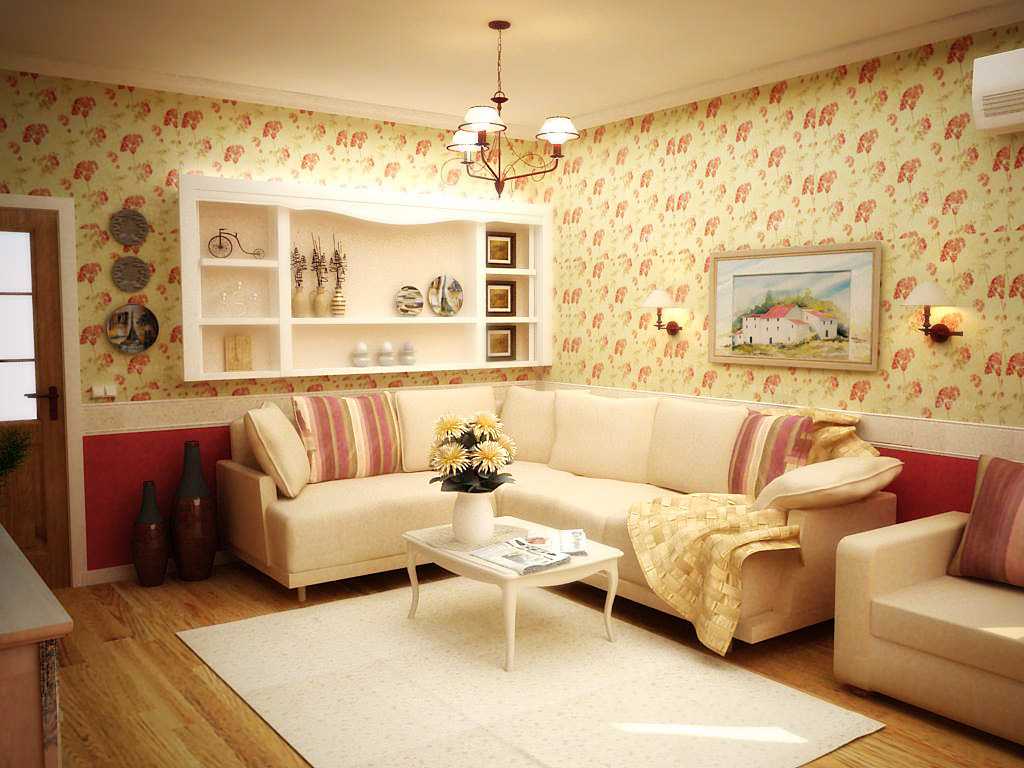
Provence Interior Design Idea

Provence style room design
Business card style - a lot of fabrics made from natural fibers with a small floral pattern. Large French windows have light curtains with ruffles and draperies. In such an atmosphere it is always comfortable and cozy - soft lighting, natural fabrics, tapestry upholstery of sofas and chairs with high legs, pleasant to the touch.
In the apartment “near Provence” everything looks pretty nice, but not “plainly”. To recreate the rural surroundings of the south of France will help:
-
onion and garlic "garlands";
-
bundles of herbs and sprigs of lavender hanging from beams under the ceiling;
-
numerous boxes with spices;
-
vegetables in wicker baskets;
-
handmade napkins and tablecloths;
-
canvas towels with embroidery;
-
vases with dry or live bouquets.
Country houses in the spirit of the French country are not distinguished by minimalism, like the Scandinavian log cabin or the Russian hut.The interior has a lot of small items and floral decorations, often there are hours of combat.
Coolness is felt in the buildings of Provence, and this feeling is achieved not only by the method of construction, but also by the predominance of “cold” shades in the decoration. In summer, the south of France is very hot, so the white, lilac and blue colors create the illusion of coolness. Large windows are covered with light curtains, letting in a lot of fresh air in the morning and in the evening, during the sultry hours they are closed. This is another specificity of the interior with elements of Provence and its difference from other varieties of country.

Provence style in the interior of a modern apartment

Beautiful apartment design in provence style
The characteristic elements of the style are systematized in the table
|
1. |
Construction Materials |
Stone, adobe brick, clay, wood, tile |
|
2. |
Finishing materials |
Fireclay clay and gypsum for plastering, whitewashing of lime with chalk, planed boards, polished stone, ceramic tiles, painting |
|
3. |
Fabrics |
Natural materials (linen, cotton, viscose, wool) with a pattern or a harsh canvas, an excess of textiles in the decoration |
|
4. |
Palette |
Light pastel shades for the background, olive, blue, lavender, mustard - additional colors |
|
5. |
Decor |
Mostly handmade |
|
6. |
Theme of drawings |
Flowers, plants, fruits, pets, Gallic rooster (symbol of France), genre scenes and landscapes |
|
7. |
Dishes |
Hand-painted colored glass and ceramics, porcelain vases and jugs |
|
8. |
Fixtures |
Forging based on fabric shades, conical shades of frosted glass with a floral pattern or in the form of buds |
|
9. |
Furniture |
Openwork forging, natural or painted wood with carvings |

Provence style interior

Provence Interior Design Idea

Provence style room design
Color palette
The designer interpretation of French country can be tender pastel or quite juicy. But even the choice in favor of a bright color should be compensated by blurry shades:
-
blue or blue;
-
lilac and purple;
-
mint and olive;
-
yellow and lemon;
-
brown and beige;
-
wine red, terracotta or a touch of sunset.
The prevailing color of the Provence style interior for different rooms is white, but in its pure form it is almost never used for wall decoration. Rather, it is light beige, a shade of ivory, milky, creamy or delicate peach tone. But crystal clear whiteness is quite possible on furniture and curtain fabrics, in china and on a paper basis of modern wallpaper.
For each functional room, the most suitable basic tone is selected:
-
olive color fits perfectly into the interior of the hallway;
-
the white living room with beige furniture looks elegant, welcoming and relaxed;
-
beautiful bathroom in blue and blue shadow transitions of ceramic mosaic with floral inserts;
-
the peace and tranquility of a Provence-style bedroom in the interior of the apartment will emphasize the choice of walls, curtains and bedspreads in shades of lavender.
Despite the fact that handmade ceramics is characteristic of all varieties of country, in the southern French provinces the material did not take root as a basis for interior decoration. Picturesque fishing villages along the Mediterranean coast are slender rows of white houses under a reddish ceramic tile. But today ceramics are used only as utensils and floor tiles - in the hallway or in the kitchen design in the style of Provence.
For decor, you can borrow any natural shade that is characteristic of the local landscape. Even in the classic trio “white-red-blue” saturated colors are not used, but their natural shades are blurred. For example, azure, cream and burgundy. The same is true for green, yellow and purple hues.

Provence style in the interior of a modern apartment

Beautiful apartment design in provence style
Characteristic finish
-
The walls of the à la Provence house are distinguished by rough stucco, where minor defects are not ruled out. This is typical for masonry, when it is impossible to achieve an absolutely vertical or perfectly smooth surface. In the kitchen and hallway, such plastering allows "bald spots" in the form of masonry, where part of the material protrudes, but the seams are well processed and bleached.
In the living room, bedroom, nursery and bathroom, such bumps are unacceptable - the walls are smooth, well plastered for whitewashing or painting. In modern styling, texture plaster, artificial stone, wallpaper, lining and other materials that fit into the design concept are widely used. Tiles and cladding bricks are suitable for finishing some rooms.
Tip. To design a boy’s room in this style, use marine motifs. In the girl’s room, flowers dominate, creating a romantic atmosphere.

Provence style interior

Provence Interior Design Idea

Provence style room design
If it is not possible to buy wallpaper with lavender or wildflowers, you can experiment with other colors typical of country. A great addition to a small hallway will be wall murals with a rustic landscape or endless lavender fields extending beyond the horizon.
-
Natural wood prevails in the flooring, which has been an uncontested option in all country styles since its inception. But the modern budget interior of a wooden house in the Provence style allows the use of eco-veneer and laminate - for the purpose of practicality of cleaning and saving on repairs.
-
The ceilings are whitewashed or painted between wooden beams, but they may not be in the interior. White or light blue is preferred because they support the most light reflection. Glossy stretch fabric (finish with a mirror effect) in rural styles is inappropriate, only matte texture.
Tip. Modern stylization with the use of wooden decor or ceiling frames is not ruled out, but everything should be moderate, with taste. Their use should be justified - fastening the decor hanging from the ceiling.
-
Wood is also used for carpentry - windows and doors are made only of natural material. In Provence they are painted with white enamel, but it is possible to cover with colorless varnish if the texture of the wood is beautiful. In the decoration, panels, carving and molding are widely used, for the interior options glass inserts are typical.
"Correct" Provence style furniture
If everything is clear with the choice of palette and finishing materials, then the furniture is worrying. Today there is no problem with buying ready-made samples from the catalog in the Provencal style. Most often offered:
-
ready-made "kitchen";
-
"Hallway";
-
table set;
-
couch with an armchair;
-
a bed for a bedroom;
-
wardrobe and sliding wardrobe;
-
children's furniture sets in French country (this is indicated in the technical description).
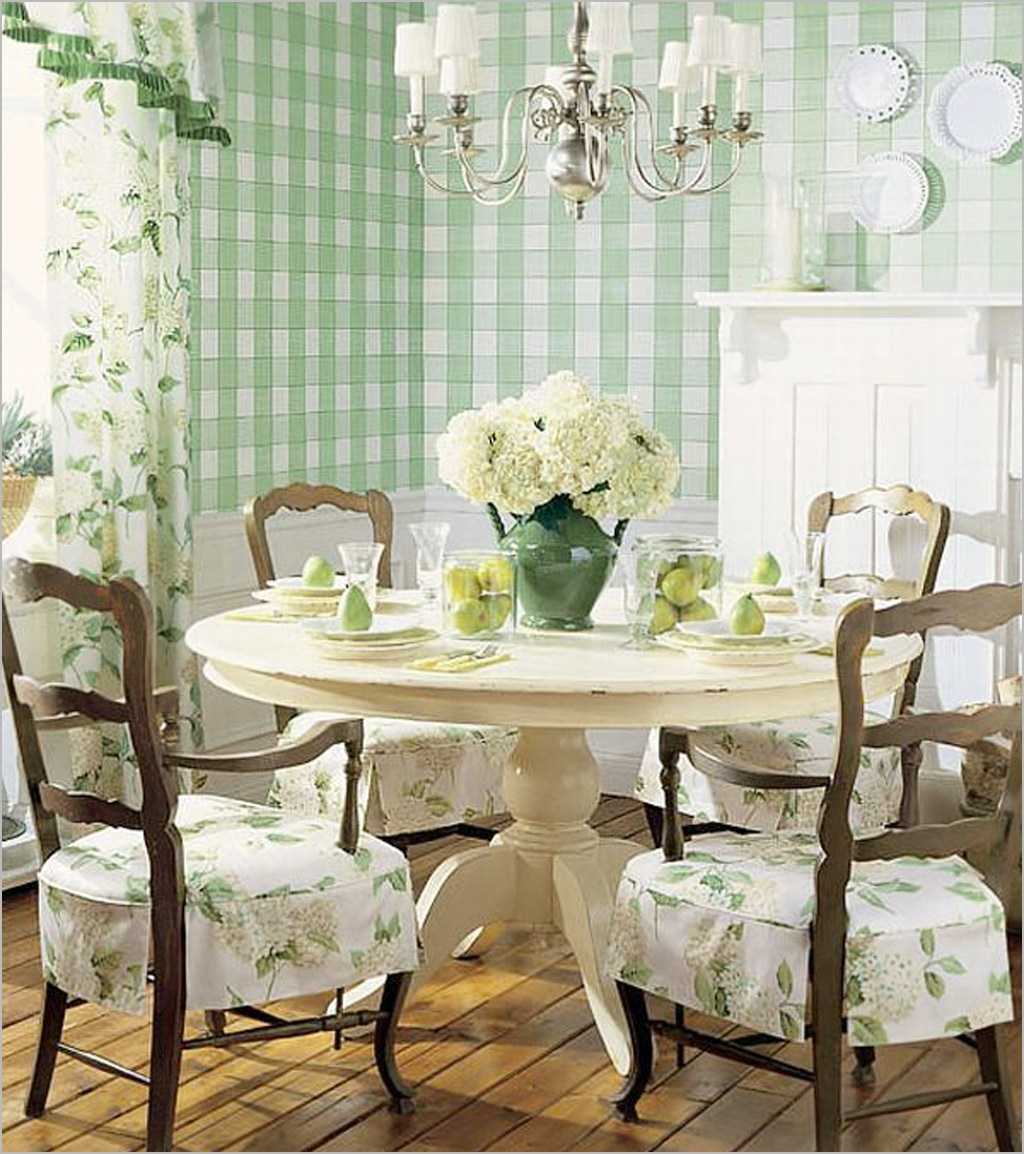
Provence style in the interior of a modern apartment

Beautiful apartment design in provence style
Along with these models, it’s easy to adapt handmade furniture to the environment, especially after restoration and painting. Of greatest interest is antiques and stylization, where there are carved inserts and glass doors. Upholstery of an old sofa or armchairs (canapes, couch with elegant legs) can be replaced with new furniture fabric. For country, a tapestry with floral patterns, striped mattress fabric or jacquard is suitable. Widely used covers for upholstered furniture and chairs.
Old chests and chests of drawers, cupboards and coasters for ficus, dressing tables and wooden tables, and preserved in old houses, after the upgrade will take their rightful place in the interior. In Provence, family values and traditions have always been treated with great care. Furniture, dishes, textiles and decor were inherited.
An attractive image of rustic coziness will be complemented by paintings for the interior in the Provence style (landscapes, still lifes), multilayer curtains with ruffles and folds, a fireplace and mirrors in carved frames.
Video: Provence-style interior design



